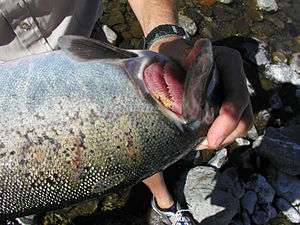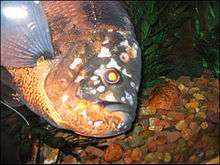List of aquarium diseases
The following is a list of aquarium diseases. Aquarium fish are often susceptible to numerous diseases, due to the artificially limited and concentrated environment. New fish can sometimes introduce diseases to aquaria, and these can be difficult to diagnose and treat. Most fish diseases are also aggravated when the fish is stressed.
Common aquarium diseases include the following:
Freshwater
| Disease | Cause | Fish Affected | Image | Symptoms | Treatment |
|---|---|---|---|---|---|
| Piscine Tuberculosis | Mycobacterium marinum bacteria | All | Weight loss evident on underparts, with corresponding loss of appetite. Discoloration. Bulging eyes. | None | |
| Fin Rot | Bacterial | All | Erosion at edges of fins | Improve water quality, remove fin-nippers and feed Vitamin C - enriched food. Use antifungal treatment to prevent secondary infections | |
| Mouth Fungus or Columnaris | Flexibacter bacteria | All, especially Livebearers |  | Cottony growth near jaws. Loss of appetite | Improve water conditions. Use commercially available antibiotics |
| Swim Bladder Disorder | May be bacterial, or caused by chilling or digestive issues | All, especially Balloon Mollies | Inability to balance in the water | Check water temperature. A medical bath may help. | |
| Vibrosis | Vibro bacteria | All | Discoloration, reddish staining of fins, bulging eyes, lethargic behavior | Medicated food | |
| Pseudomoniasis | Pseudomonas bacteria | All | Hemorrhages in mouth and ulceration on body | Medicated food | |
| Saprolegnia Fungus | Fungal | All | Whitish, furlike growths | Vitamin C enriched food, or a commercial remedy in a medical bath. Check to make sure that your fish doesn't prefer Brackish water | |
| Egg Fungus | Fungal | Eggs only | Fungal growths on eggs | Remove affected eggs. Use Methylene blue to medicate the hatching tank. | |
| Lymphocystis | Viral | All | Cauliflower-like growths and white areas around the eyes | Vaccines may be available | |
| Iridovirus | Viral | Gouramis, angelfish, Ramirez Dwarf Cichlids and others | loss of appetitie. Darkening in color. Enlarged abdomen. Occasionally Lymphocystis | None | |
| Singapore Angelfish Diseases | Angelfish | Inactivity, loss of appetite, high and rapid mortality | None | ||
| Malawi Bloat | Probably viral | Lake Malawi Cichlids, especially vegetarian ones | Similar to Dropsy | Offer a high-fiber diet | |
| White Spots (Ick) | Ichthyophthirius multifiliis parasite | All | Small white spots, which may ulcerate | Raise water temperature slightly and treat water with commercially available remidies | |
| Hole-in-the-head | Haxamita parasite | Discus and Cichlids |  | Pale ulcerated area around head | Micronazole or similar medication. Use food containing Vitamin C |
| Neon Tetra Disease | Pleistophora hyphessobryconis Parasite | Neon Tetras | Discoloration | None | |
| Skin or Gill Flukes | Gyrodactylus and Dactylogyrus parasites | All | Labored breathing, scraping against objects, abnormal gill function | Commercially available medication | |
| Anchor Worm | Lernaea parasite | All | Visible parasites attahced to body leading to ulceration and irritation | remove parasites with forceps and use medicated bath to prevent secondary infection. Insecticide may help | |
| Dropsy | Varies from temperature, to indigestion to infection | All |  | Bloat, scales stick out | Varies depending on the cause |
| Tetrahymena | Parasite | Freshwater fish |
Saltwater
This list is incomplete; you can help by expanding it.
- Cryptocaryon (marine ick)
- Marine Velvet or Coral Reef Fish Disease
- Anemonefish Disease
Both
| Disease | Cause | Fish Affected | Image | Symptoms | Treatment |
|---|---|---|---|---|---|
| Marine velvet | Amyloodinium parasite | All, fresh and salt water | Powdered appearance, gasping and disorganized swimming | ||
| Velvet Disease | Oodinium and other parasites | All salt and freshwater fish |  | Golden dots, rubbing against rocks while swimming | |
| Septicemia or Egtved virus | Viral hemorrhagic septicemia virus | Many fresh and salt water fish |  | hemorrhaging, internal and external | Virkon AQUATIC |
Uncategorized
- Myxobacteriosis
- Ichthyobodo (costia)
Quarantine
The goal of quarantine is to prevent problems in the main tank due to sickness. A quarantine tank should be used before to introduce any newly acquired animals in the main tank and to treat fish that are already sick. By doing this, the aquarist can avoid the spread of the disease and make it easier to treat the fish.[1]
See also
References
- ↑ "How To Quarantine Aquarium Fish And Invertebrates". Aquariums Life. 2009-03-24. Retrieved 2015-09-18.
Bibliography
- Encyclopedia of Aquarium and Pond Fish (2005) (David Alderton), DK Publishing, ISBN 978-0756609412
External links
This article is issued from Wikipedia - version of the 12/3/2016. The text is available under the Creative Commons Attribution/Share Alike but additional terms may apply for the media files.